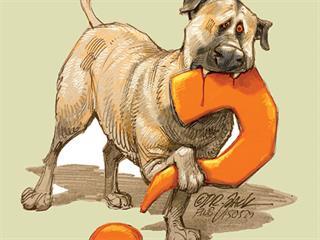
At various meetings that I have attended, I have heard farmers who had acquired Anatolian guard dogs describe how their dogs chased game, even killing them in some cases. Despite having paid a couple of thousand rands for each dog, some farmers had resorted to shooting their dogs because of the problems they caused.
Research
In 2002, Dr Laurie Marker of the Cheetah Conservation Fund in Namibia completed her PhD thesis on the biology, ecology and conservation of the cheetah on Namibian farms. It included an investigation of alternative control methods for livestock predation, particularly a study of 157 guard dogs. The research revealed that behavioural problems affected 94,4% of the dogs, and correctional training enabled only 61% of the dogs to be deployed.
The three greatest problems were: 44% of the dogs chased game (there were no statistics on how many animals were killed), 37% stayed at the kraal without accompanying the sheep to the field, and 25% harassed or killed sheep. Some dogs were guilty of more than one of these behaviours. In the end, 43% of the dogs had to be removed from the project because the behavioural problems could not be corrected or the dogs died. Of the dogs that died, 21% were shot by the owner, and a further 6% were shot by a neighbour or other farmer, while the rest died because of accidents, disease or poison.
Marker mentions that studies from the US mirrored local statistics, with about a third of guard dogs being shot by their owners. Remarkably, the average working life of the dogs at the time of death was not even 4½ years.
These conclusions were reinforced with the publication in 2011 of Gail Potgieter’s MSc thesis: The effectiveness of livestock guarding dogs for livestock production and conservation in Namibia [Nelson Mandela Metropolitan University’s Department of Zoology] on the use of Anatolian Shepherd/Kangal dogs to protect livestock from predators in Namibia. Dr Marker was one of Potgieter’s supervisors.
The dogs were placed with commercial as well as with communal farmers. About two- thirds of the guard dogs in the study was accompanied by a shepherd. Although 30% of commercial farmers experienced no difference in predator damage, 76% of all farmers in the study were satisfied that there had been a significant decline in livestock losses.
The question, however, was how predator- friendly the dogs were. About 63% of the Anatolians had killed animals. Thirty-seven of the dogs had killed jackal, nine had killed baboons, three had killed caracal and one had even killed a cheetah. Various other dogs had killed a bat-eared fox and an African wildcat. In all, at least 83 animals had been caught by Anatolian dogs, and this is an underestimate, as some farmers who reported their dogs killing animals could not give numbers.
After the dogs were deployed, the farmers reported that they were killing significantly fewer jackal and caracal themselves. But combining this figure with the dog kills brought the number of jackal and caracal kills to more or less double the number killed before deployment of dogs! The number of cheetah killed had declined sharply, however.
A number of international conservation specialists recommend a combination of lethal and non-lethal controls where damage-causing animals are plentiful.
Comparisons with well-funded overseas efforts
Unlike the South African situation where human-animal conflicts are managed by Nature Conservation, in the US the National Wildlife Services and the National Wildlife Research Centre (NWRC) resides within Agriculture. South Africa’s nature conservation departments suffer from chronic underfunding.
The first noticeable difference with the US system is its budget for wildlife services which in 2012 was nearly US$150 million (R1,77 billion), with the NWRC getting about US$15 million (R177 million). This organisation claims to be the world leader in the field of non- lethal damage control, and there were studies done in the 1980s on the use of guard dogs.
This organisation, with more than 50 highly qualified researchers and more than adequate budget, could not over a period of 30 years come up with non-lethal methods that could fully replace all lethal methods – and they currently seem to be out of ideas.
Shortly before the turn of the century, non-lethal control of coyote was receiving considerable attention from NWRC. By 2011, its research was focusing on control of coyotes through the development of a new poison from natural substances which would not cause secondary poisoning or pollute the environment.
By 2014, it was looking at ways of increasing the selectivity of the M44, an apparatus that shoots poison into the mouth of the coyote. Another example comes from Australia. The 1080 poison has been in use in Australia for over 50 years to rid them of all kinds of ‘problem animals’. However, the Australian government is now limiting the use of this substance and is looking at replacements. (Note: this example is not predator related).
The government supplied AU$5 million (R47 million) to find alternative solutions. Researchers from a variety of disciplines worked with environmental activists on the ‘Alternatives to 1080’ programme. The outcome in 2011 was that shooting by professional hunters was found to be the only solution that could achieve relief to the problem and produce a result comparable to 1080. The only other potential solution that is still being refined is the use of another poison that does not have the negative environmental effects of 1080.
Back home
To return to the Anatolian guard dogs. Published guidelines on best deployment of guard dogs stipulate that a dog, depending on terrain and vegetation, can guard 200 to 300 head of sheep in an area of about 200ha to 300ha. Although a dog’s senses are far more acute than a human’s, logic dictates that a dog cannot guard such a vast area. I therefore question published articles reporting that one dog could drastically reduce losses on a 6 500 ha farm and a flock of over 3 000 sheep. Or could this be an example of how effective the dogs are in killing jackal or caracal?
The ideal of striving for predator-friendly solutions must be pursued. But many millions of rands will have to be spent before this ideal is achieved.
Email Thys de Wet at [email protected].













